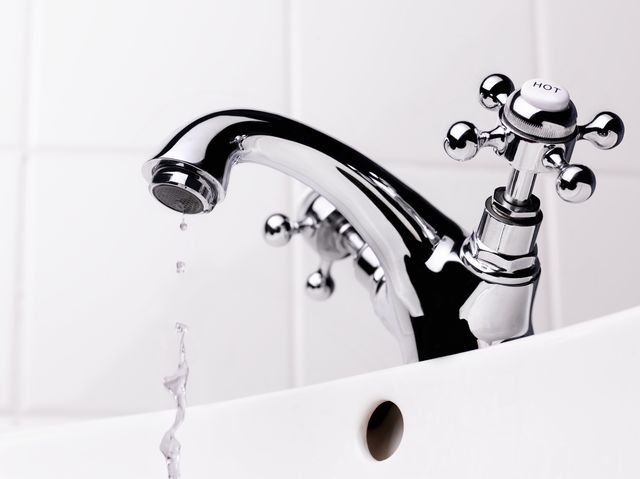How To Fix A Sinking Mattress

Peter Dazeley Getty Images
It's entertaining season and the LAST thing you need is a clogged sink or leaky faucet getting in the way of your fun. But you CAN fix it yourself. We believe in you.
How To Fix A Clogged Drain/Sink
Bathroom drains can easily get clogged with hair, kitchen sinks with waste food or vegetable peelings. You might need to remove the sink's P-trap to clear a blockage, or if you lose something valuable. Use chemical drain cleaner only as a last resort.
You'll Need:
Rubber Gloves (optional)
Damp Rag or Cloth
Plunger
Bucket
Slip Joint Pliers OR Adjustable Wrench
Getting Started:
Once you notice a clog, use the sink as little as possible so that you don't aggravate the problem. Gather all the tools you will need for the job before starting. Wear rubber gloves to help with grip and to protect your hands against any unpleasant waste
What to do:
1. Fill the clogged sink halfway with water, if not already full. Block overflow hole with damp rag or cloth.
2. Cover the sink drain opening with the cup end of plunger, ensuring that the plunger is full of water. Push down firmly but carefully and lift slowly, repeating until blockage clears.
3. When the blockage has cleared, run hot water down the sink drain for several minutes. Unblock the overflow hole.
4. If the blockage has not cleared, locate the P-trap — it's the U-shaped pipe that connects the vertical pipe coming from the sink to the horizontal pipe that goes into the wall. Place the bucket under the trap to catch any spills.
5. Unscrew the trap. If too tightly fixed to unscrew by hand, use slip-joint pliers.
6. Pull away the trap; it will be full of dirty water so let it fall into the bucket.
7. Empty the trap into the bucket and look for any lost valuables. Clean the trap of any hair or food debris.
8. Reassemble the trap, taking care not to over tighten. Run hot water for several minutes to ensure that the clog has cleared. If the blockage persists, check outside drains.
How to Nail It:
- If you lose something valuable down the sink, turn off the water as soon as possible so that the item doesn't get washed out of reach.
- Use sink strainers to help minimize future blockages.
- If the P-trap hasn't been loosened for a while and you need to use pliers or a wrench, protect the pipe with a cloth so you don't damage it.
How To Repair A Leaky Faucet
On older faucets, drips can often be stopped by replacing a washer. On many modern faucets, you may need to replace the interior cartridge that houses all the important parts.
You'll Need:
Screwdriver
Pliers
Slip Joint Wrench, or Wrench to Fit
Replacement Cartridge or Washer
Silicone Grease
Heavy Cloth, Piece of Leather, or Duct Tape, If Needed
Getting Started:
First, turn off the water supply. There is usually a valve under the sink or behind the shower assembly, or you may find a screw slot, which you'll need to turn with a screwdriver until it points across the width of pipe rather than along its length. Otherwise, turn off the water supply to the whole building. Turn the faucet on and wait until you have cleared any residual water from the pipes.
Put the plug in the sink in case any small screws or nuts fall out while you're taking the faucet apart. It's a good idea to put these aside somewhere safe so that you can locate them easily when reassembling the faucet.
What to do:
1. Remove decorative handle cap (often marked "hot" or "cold"). Remove screw underneath, then jiggle the handle to remove. A screwdriver or slip joint pliers may be needed at any stage.
For Modern faucets: remove interior cartridge using pliers. Note: it may be held in by a lock ring or retaining nut that will need removing first, using a wrench. Replace with new cartridge.
For Older faucets: use wrench to undo retaining nuts, remove headgear, and reveal old washer. Prize out the washer and replace it with a new one.
2. Apply silicone grease to the screw threads, then reassemble the faucet in reverse sequence.
3. Turn water supply back on. Check for leaks in reassembled faucets.
4. If the problem continues, you may need to replace the faucet.
How to Nail It:
- Use a cloth, piece of leather, or some duct tape to protect the faucet if using pliers on chrome surfaces.
- If the old washer is hard to remove, try levering it off with a screwdriver.
- Check that your replacement washer is exactly the same size and style as the old washer.
Excerpted from DIYHome Repairs: 100 Fix-It Yourself Projects Copyright © 2014 Sarah Beeny and published by Quadrille Publishing Limited / F+W Media, Inc. Usedby permission of the publisher. All rights reserved.
This content is created and maintained by a third party, and imported onto this page to help users provide their email addresses. You may be able to find more information about this and similar content at piano.io
How To Fix A Sinking Mattress
Source: https://www.housebeautiful.com/home-remodeling/renovation/how-to/a3398/how-to-fix-a-clogged-sink-and-leaky-faucet/
Posted by: cotahersh1969.blogspot.com

0 Response to "How To Fix A Sinking Mattress"
Post a Comment